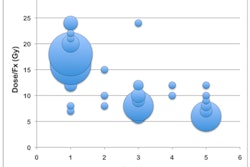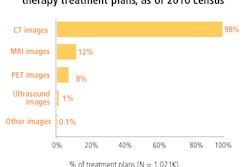The verdict won't be in for years. But early outcomes were encouraging for prostate cancer patients treated with stereotactic radiation therapy (RT), according to research presented at the American Society for Radiation Oncology (ASTRO) annual meeting held earlier this month in San Diego.
Four scientific presentations reporting the use of hypofractionated radiation to treat men with organ-confined prostate cancer conveyed cautious optimism about quality of life and toxicity outcomes. Collectively, these represent the experiences of 400 patients, the majority of whom have been followed for less than three years.
The largest clinical trial
The largest number of patients are enrolled in a 20-institution clinical trial supported by an unrestricted educational grant from Accuray of Sunnyvale, CA. Principal investigator Robert Meier, MD, radiation oncologist and medical director of the Swedish Cancer Institute of Northwest Hospital in Seattle, reported that 254 men underwent treatment between November 2007 and May 2010.
The men ranged in age from 40 to 89, with a mean age of 67. All patients had been diagnosed with low- to intermediate-risk organ-confined prostate cancer, and had not received any prior treatment or taken hormone therapy. MRI fusion was used to assist in target localization. Treatment was performed with a nonisocentric robotic stereotactic radiation therapy platform (CyberKnife, Accuray) with real-time tracking of implanted gold fiducial markers.
About 200 beams were employed to deliver five fractions of 8 Gy of radiation dose to the prostate. Intermediate-risk patients, representing 52% of the patient cohort, concomitantly had 36.25 Gy in five fractions delivered to the proximal seminal vesicles.
"One hundred fifty-one patients have been followed for one year or more," Meier reported. "Acute toxicities have been acceptable. With the caveat that our follow-up is so limited, late toxicities appear to be acceptable. Quality of life is comparable to the outcomes from treatment with other modalities. Initial [prostate-specific antigen (PSA)] responses appear to be encouraging."
Approximately 80% of the patients experienced a grade 1 or 2 genitourinary toxicity, and approximately 50% had a gastrointestinal toxicity. But none of the patients had a grade 3 toxicity within 90 days of treatment. The majority of acute toxicities experienced within three months of treatment were urination frequency/urgency (60%, 14% were grade 2), followed by dysuria (50%, 14% grade 2), retention (37%, 7% grade 2), and stool frequency (30%, 2% grade 2).
A total of 31% of the patients who were followed for at least one year experienced late genitourinary toxicity, but for the majority (23%), the toxicity was grade 1. Only 7% of the patients experienced late gastrointestinal toxicity (6% at grade 1).
Meier reported that two patients experienced grade 3 late toxicities approximately one year after treatment. One patient had had a bladder neck necrosis and the other patient had a urethral stricture. One session attendee expressed concern that these occurred so soon after treatment, noting that these specific late toxicities typically appear several years following treatment, and Meier acknowledged that this was a valid issue.
The median PSA at the start of treatment was 5.6, which has dropped to a median of 0.7 at the second year of treatment. Meier reported that only one patient experienced a PSA increase greater than 2 ng/mL; the patient was subsequently diagnosed with a nodal metastasis.
Meier and colleagues used the Expanded Prostate Cancer Index Composite (EPIC) questionnaire to assess quality of life. Baseline and one-year responses were comparable with respect to urinary and bowel functions.
"Unfortunately, sexual function score continuously dropped, from 50% of the patients reporting that they had erections adequate for intercourse at baseline to only 39% one year following treatment," he said.
Positive five-year outcomes
In another study presented at ASTRO, a group of 40 men who received stereotactic hypofractionated RT at Virginia Mason Medical Center in Seattle also had positive outcomes, according to Huong Pham, MD. Pham presented a five-year outcomes update of the phase I/II clinical trial, in which patients received treatment between August 2000 and July 2004.
These patients, who ranged in age from 50 to 82 when they were diagnosed with T1-2b low-risk localized prostate cancer, had Gleason scores of 5 or 6 and PSA levels less than 10 ng/mL. After having three gold fiducial markers implanted for daily stereotactic localization, they received a total radiation dose of 33.5 Gy while lying in a prone position, in five daily fractions to the isocenter.
The median PSA nadir at five years was 0.65 ng/mL. A benign PSA bump was observed in 22.5% of the patients, Pham reported.
"Late gastrointestinal and genitourinary toxicities experienced three months after treatment have been low," she said. "Only 30% of the patients experienced late gastrointestinal toxicities [22.5% grade 1 and 7.5% grade 2], and only 38% experienced late genitourinary toxicities [22.5% grade 1, and one patient each grade 2 and grade 3]."
The overall five-year biochemical-free survival rate, presuming a nadir + 2 ng/mL, was 93%, with five patients failing. One patient underwent a salvage prostatectomy, one patient had a prostate brachytherapy procedure with iodine-125 seed implants, and three patients were conservatively management with either hormone therapy or observation.
To date, 12 patients have died, but no deaths were attributed to prostate cancer, Pham reported. Of the 28 patients in the cohort alive, 26 self-reported having sexual function prior to having radiation therapy treatment. Half of these patients reported that they still had potency nine to 96 months following treatment.
Encouraging quality of life
Flushing Radiation Oncology in Flushing, NY, and CyberKnife of Long Island in Greenlawn and Smithtown, NY, represent three cancer treatment centers that reported on the four-year quality-of-life outcomes of 50 patients treated with stereotactic RT using the CyberKnife system for low- and intermediate-risk organ-confined prostate cancer.
These patients had been diagnosed at a median age of 69, had a PSA level of 15 ng/mL or less, and had a Gleason score of 6 or less. Both CT and MRI exams were used for treatment planning, followed by the implantation of four gold fiducial markers used for continuous tracking.
All patients received a 5-Gy radiation dose daily, for a total dose of 35 Gy, delivered with two collimators and 140 to 170 beams in a 45-minute treatment session, according to Alan Katz, MD, a radiation oncologist at Flushing Radiation Oncology. All patients received a 1,500-mg amifostine enema prior to each treatment. The dose was prescribed to the 83% to 87% contour line covering 95% of the patient tumor volume. The patients' testes received a mean dose of 5.1 Gy.
"Toxicities have been minimal," Katz said. "Four years after treatment, 29 of the 36 patients who reported sexual potency at the time of diagnosis report they are still sexually active. This represents a potency preservation rate of 80.5%"
Seventy-five percent of the patients experienced acute urinary toxicity, and 80% experienced rectal toxicities. But only 4% for each toxicity was grade 2, and no patient had any grade 3 toxicity or had a problem with urinary retention. For the majority of patients, EPIC scores returned to their baseline levels within 12 months of treatment.
"As for late toxicities, only 10% of the patients experienced urinary toxicity, of which 6% were grade 1 and 4% were grade 2. Only 6% had rectal toxicity, of which 4% were grade 1 and 2% were grade 2. No patients have experienced any grade 3 toxicities to date," Katz reported.
Three patients in this study died of other causes. At a median follow-up of 48 months, the median PSA of the remaining 47 patients was 0.10 ng/mL.
Stereotactic body RT (SBRT) monotherapy treatment
21st Century Oncology of Fort Myers, FL, uses a 4D localization system for real-time electromagnetic target tracking (Calypso Medical Technologies, Seattle) with combined volumetric setup verification and intensity-modulated radiation therapy (IMRT) (Trilogy, Varian Medical Systems, Palo Alto, CA) to treat some of its patients diagnosed with low-risk prostate cancer.
Patients who qualify for this treatment have clinical stage T1c-T2a, a PSA level of 10.0 ng/mL or less, and a Gleason score of 6 or less. They also cannot have a prostate ultrasound volume greater than 60 cc, poor baseline urinary functions, or hip prostheses, and they cannot have undergone prior hormonal or other therapies for prostate cancer.
Radiation oncologist Constantine Mantz, MD, reported the quality-of-life and toxicity outcomes of 54 patients who have completed treatment since January 2007. All patients have been followed for a minimum of one year and a median of 26 months.
Prior to treatment, patients underwent ultrasound-based transrectal placement of three Calypso transponders with 1.5-cm separation among them. Five days later, postimplant treatment planning CT and MRI imaging was performed.
A total dose of 40.0 Gy was delivered in five every-other-day fractions of 8.0 Gy prescribed to a planning target volume calculated as the prostate volume plus a 3-mm margin.
"At treatment delivery, the 4D localization system was first used for rapid target alignment," Mantz explained. "A conebeam CT scan was then obtained to verify the alignment and for assessment of possible target deformation relative to the planning scan. If there was disagreement between the initial Calypso setup and the conebeam CT verification, we would then realign starting again with the Calypso system."
"Once treatment started, the Calypso system would monitor the position of the target in real-time and would provide an update of its position every 10th of a second," he said. "The beam would be interrupted manually at the treatment console if any excursion of 2 mm or greater were observed for any length of time. If the treatment interruption was greater than two minutes, the patient and the target would again be realigned."
No patient experienced grade 3 toxicities. Urinary frequency was the most prevalent toxicity, with 42.5% of the patients experiencing this one month following treatment, and 5.5% still at one year. Approximately 17% had dysuria one month after treatment, which resolved for 13% within 90 days. Fifteen percent experienced urinary obstruction within the first month, which resolved for 13% within a year.
Two patients reported low-grade rectal bleeding at six and nine months, respectively, which did not require clinical intervention. Thirteen percent of the patients experienced diarrhea, but this was only within the first 30 days following treatment.
The EPIC questionnaire was used for assessing sexual function, rectal function, urinary irritation or obstruction, and urinary incontinence. There was a clinically significant decline only for urinary irritation and obstruction.
"Early biochemical response following SBRT was rapid and resembles postbrachytherapy responses," Mantz concluded. "The mean PSA of our cohort was 6.92 ng/mL, and this fell under 1.0 sometime shortly after the first 12 months. We have not observed any biochemical failure yet in this highly selected group."
By Cynthia E. Keen
AuntMinnie.com staff writer
November 23, 2010
Related Reading
Tumor tracking for prostate IMRT reduces GI side effects, March 26, 2010
CyberKnife benefits prostate cancer patients, October 1, 2009
SBRT for early prostate cancer shows promising interim results, April 9, 2009
NY Times: CyberKnife Medicare coverage varies in U.S., December 23, 2008
Copyright © 2010 AuntMinnie.com



















